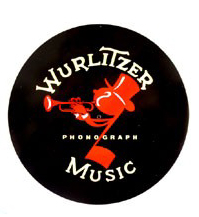
COMPANIES THAT MADE JUKEBOXES
Put another Nickel In!

Here are some helps to finding things on our various pages about Jukeboxes. This particular page is devoted to the business (legal and illegal) aspects of the coin-operated phonograph industry.
- Overview and Introduction (This Page)
- Part 1: Mechanics (Separate Page)
- Part 2:Julebox Aesthetics (Separate Page)
- Part 3: Juke Box Companies (THIS Page)
- Concluding Note and References (Separate Page)
This "Introduction" is on all of our jukebox pages. If you have read it before (or don't want to read it), you can go directly to the stories about this industry.
If you're reading this in 2009 (or later), the word "jukebox" means a gaudy prop in a retro diner or an image on a "Fabulous Fifties" party favor. In fact, if it wasn't for places like the Silver Diner, most of you would have never seen or heard of a jukebox. It is about a 50-1 bet that none of you have ever seen a real mechanical jukebox playing 78 rpm records, and it's about 1000-1 that any of you ever played a song for a nickel in a roadhouse. I'm writing this to integrate a lot of information that's out there on the internet. So far, we have tried to give you get a little history, a little mechanical engineering, and a true aesthetic experience. On this page, we'll look at business strategy. All along, we have tossed in in some of the original patents so that you can see how things work.
First of all, they're not jukeboxes -- back in the day, they were known as coin-operated phonographs. They were found in the best of establishments and were a multimillion dollar business. The cast of characters includes a wide variety of colorful individuals including brilliant designers, a millionaire right-wing Senator, gangsters, and even the KGB. This was cutting-edge technology that pushed electro-mechanics to its limits. It was the beginning of "hi-fi" and it was the pulse of the nation's taste in music -- the Radio and TV show Your Hit Parade informed listeners that the ratings were based on a survey of:
"the best sellers on sheet music and phonograph records, the songs most heard on the air and most played on the automatic coin machines, an accurate, authentic tabulation of America's taste in popular music."
Most people who danced during the period 1930-1950 did so to music provided by a jukebox. With the exception of the very, very elite places, most restaurants from Chez Pierre to the Pete's Place had a coin-operated phonograph to provide dance music for their customers. It is generally estimated that between two and three million boxes were made. The folks who made coin operated phonographs (principally Wurlitzer, AMI and Seeburg) engaged in large scale nationwide advertising campaigns to convince poeople that the jukebox was a legitimate and "high-class" form of entertainment. Of these, Wurlitzer is the most remembered name, thanks to two factors: a remarkable series of full-page ads drawn by Albert Dorne and the Model 1015 Jukebox, as shown below:
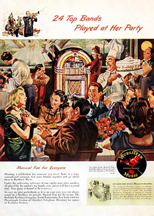
1947 Albert Dorne Ad Featuring the Wurlitzer Model 1015 Jukebox
Click to Enlarge
By examining this ad, we can learn a little about the times. First, you'll note that this scene takes place in a fairly classy restaurant -- the waiter (upper left) is wearing a mess jacket. There is a mural of a prince and princess on the wall, and the headwaiter (smiling at the kitchen door in black tie) is presiding over a birthday party for a lucky young lady. Not only that, a cliche chef in toque and pencil moustache has prepared a special (and large) birthday cake. There are a dozen roses on the table. All of the [clearly] non-ethnic patrons are having the time of their life. There is nothing at all about this scene that could be remotely considered as "low class." Below are some ads from the Seeburg company's internal paper. One shows a really classy Art Deco bar that had recently been "closed" to jukeboxes; the other shows a white-tie wedding with music by a jukebox. [this was only possible in the Seeburg magazine...]
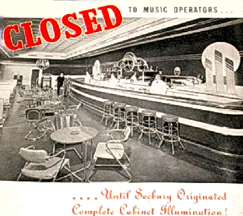
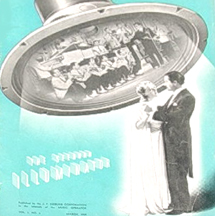
Seeburg Ads suggesting that the Juke was High Class
Click to Enlarge
As you might guess, there is a little sociology involved here. Manufacturers were continuously improving the technology and appearance of their products, sometimes with new variants issued on a monthly basis. The "very latest" machines with the most features and the best styling were designated "Top Boxes" and were destined for high end establishments. As the new moved in, the old was recycled down the status chain (of the time) until they reached rock bottom in the seedier roadhouses. In those bigoted times, when the machines reached into Negro neighborhoods, they acquired their enduring name, since "Juke" was slang at the time for "dancing". This is a lot less of a mouthful than "automatic coin operated phonograph," so like "Jitterbug", "Zoot" and "Rebop" the African-Americans had the last word. On a sad note, after the machine had been recycled down the chain, it was scavenged for parts and the rest destroyed. This is why boxes from the 1920s and 1930s are very rare.
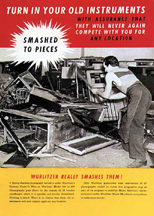
We Really Smash Them
Wurlitzer Trade Ad from the 1930s
By a new jukebox! The old one won't compete with you...
In 1942-1945, they were sent overseas with the Armed Forces
Click to Enlarge
The Model 1015 had the largest production run of any single jukebox model. Wurlitzer estimates that more than 60,000 of the units were shipped. With bubbler tubes that changed colors, it was very entertaining -- so much so that owners preferred to keep this model instead of switching to newer boxes, even those with much improved technology. When the industry moved from 78 rpm to 45 rpm records, many of the 1015s were retrofitted and continued to serve in the 1950s. The natural downward evolution of the jukebox placed this machine in malt shops, drug stores and other places frequented by teenagers just at the time that Rock'n'Roll was emerging. The 1015 is, in fact, an icon of teen culture in the mid-1950s even though it was introduced in 1947 to play the music of their parents (see ad above.). It is the most often pictured jukebox and is immediately recognizable today. In fact, the remnants of the Wurlitzer company still makes them today -- they play CDs and some even use iPod technology to offer thousands of selections.
If this has been boring, you have a some choices now:
- Read about Crime and the Jukebox
- Read about Jukebox Mechanics
- Read about Jukebox Aesthetics
- Read an Epilogue for the Jukebox Era THIS Page
- Look at Some Other Kind of Swing Era Nonsense
Otherwise, just keep scrolling down to have alook at the companies that made the jukeboxes.
Why Go Into the Jukebox Business?
Two social factors helped fuel the growth of the jukebox.
First, the public was thoroughly fascinated with the idea of "automatic service." An aricle from 1932 describes this trend:

Social Fascination with Automated Sales
Click Here to download "The Automatic Age"
From the October, 1932 issue of Popular Mechanics
Click to Enlarge
Second, there was real money to be made. In reading this section, you must remember that a nickel was worth a WHOLE LOT more during the Depression than it is now. It was not uncommon for laborers to make less than 25 cents per hour. Here are some statistics from the Works Progress Administration (WPA), the emergency employment service that put people to work during the Depression:
".. (Washington, DC) In January, 1936, 35,350 people (7.3% of the DC population) worked for the WPA.. there were four skill levels.. unskilled workers receiving $40/mo., semi-skilled workers getting $58/mo, skilled workers at $72/mo and professional/technical workers at the maximum rate of $79/mo .." [Source: The Washington Daily News February 12, 1936]
In 1936, the workweek was 48 hours long, so these wages translate to 24 cents/hr for unskilled workers up to 43 cents/hr for "professionals." These were "good jobs" in the middle of the capital of the USA and wages were much lower outside urban areas. The average working man would have to put in from 15 to 20 minutes of labor -- digging ditches, running a punch press, operating a sewing machine, etc to earn the money to hear 3 minutes of recorded music on a jukebox. [78 rpm records that were technologically limited to 3 minutes per side.] The jukebox was more like a skilled professional or middle manager because it could earn up to $1 an hour, assuming continuous play.
To help you get an even better idea of what a nickel would buy, here are some examples of prices in the 1930s:
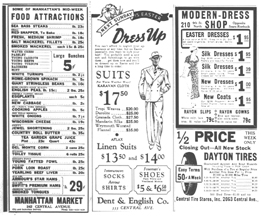
Value of a Nickel in 1936
From the St. Petersburg Evening Independent April 7, 1936
Apples were Five Cents per Pound
Click to Enlarge
The value of a nickel did not decrease that much during World war II or even into the early 1950s, when the United Steelworkers went out on strike for 53 days over an 8 cent per hour wage increase (they wanted 12 and got 4). (Parenthetically, the Steel Strike link also introduces Homer Capehart who was also influential in the jukebox industry, as detailed below.)
Inflation has reduced the value of a nickel to the point where coin may not even exist next year, much less in 2050! The point of this economic discussion is that in the 1930s, it was definitely worth investing time, materials and brainpower to capture nickels.
The Wurlitzer Company
Rudolph WurliTzer founded the famous WurliTzer company in 1856 (an yes, he spelled it with a capital T in the middle.) Rudolph had three sons, Rudolph Jr., Howard and Farny, all of whom worked for the firm. Starting in Cincinnati, Ohio, they initially imported European music machines including the products of the Regina Music Box Company. By the 1890s, they were the largest distributors for Regina. In 1900, a manufacturer of merry-go-round organs developed a coin operated automatic piano, called the DeKleist Tonophone, asked WurliTzer to distribute it. The machine was a success making DeKleist a millionaire. They also convinced Regina to add coin slides to their larger music boxes. In 1909, the WurliTzers bought out DeKleist acquired a factory in North Tonawanda, New York.
Back in Cincinnati, Farny Wurlitzer was having an affair with his secretary, and eventually married her. This was apparently a family scandal and the newlyweds were banished to Tonawanda. Exiled to make something of DeKleist, Farny Wurlitzer created a whole new industry and eventually established the WurliTzer headquarters in the small upstate New York town near Buffalo. The Wurlitzer factory grew to be nearly one quarter mile long. It was the largest woodworking, metal working and assembly plant in the world devoted to the production of musical instruments. It produced tens of thousands of pianos over the years and every one of those fantastic Wurlitzer Jukeboxes was made there.
The Wurlitzers became world famous by building and promoting large pipe organs for use with silent movies in the palatial movie theaters of the 1920s. No big city silent movie was complete without a virtuoso performance on the "Mighty Wurlitzer." As the nation's premier movie palace, Radio City Music hall had the biggest, most complicated Wurlitzer organ with two consoles that were transported into the theater on their own elevator.
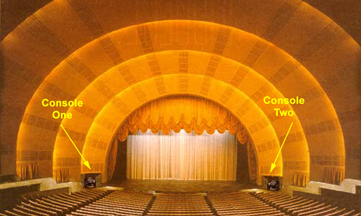
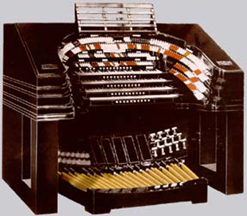
The "Mighty Wurlitzer" at Radio City Music Hall
Click to Enlarge
A combination of the Depression and Talking Pictures almost put Wurlitzer out of business. In 1928, Wurlitzer's shares sold at $119 a share. In 1933, the price was $10 a share and the company was $5 million in debt. At great risk, Wurlitzer gambled and bought the Simplex Manufacturing Company, the developers of record changing system called the Multi-Selector. This invention allowed people to push a button to select the record they wanted to hear. (Prior to this, coin operated phonographs only allowerd the customer to the next record in sequence.) Along with the Multi-Selector, Wurlitzer also acquired Homer C. Capehart, the Simplex owner. Eventually, Capehart became Wurlitzer's general manager and led Wurlitzer back to success. In 1933, before Capehart, Wurlitzer leased 300 jukeboxes. Even in the depression people could afford a nickel for a song -- if they were sufficiently entertained. Capehart's aggressive management style and a flair for the dramatic propelled Wurlitzer into a multi-million dollar company. In 1936, Wurlitzer leased 44,000 jukeboxes. As we have seen in the section on Jukebox Aesthetics, Wurlitzer was at the forefront of modern design in jukebox design. However, they were also at the forefront of business development. Capehart was also a leader in programming -- developing mechanisms for deciding which records would be hits, always seeking to maximize revenue.
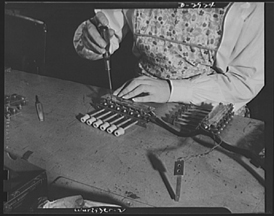
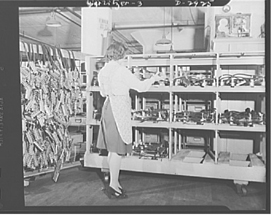
Scenes from the Wurlitzer Factory
Click to Enlarge
Here is a company-made video that shows operations at the Tonawanda Plant
PART TWO
During World War II, Wurlitzer initially shut down jukebox production to manufacture precision electronic instruments for the Armed Services. The woodworking shop, famous for pianos, organs, and fine cabinets of all sorts, was put to work making parts for transport planes. The company won (and proudly displayed) a production efficiency ("E") award.
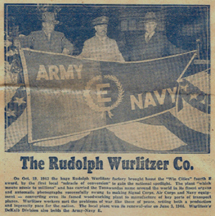
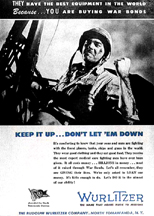
Wurlitzer at War
Click to Enlarge
There was intense demand for jukeboxes as morale builders on American bases that had spanned the globe. It was said that the Marines came first, the Seabees next, and the Wurlitzer immediately thereafter. Dancing (and the opportunity to socialize with the opposite sex) was the most popular activity at the USO clubs. Worl War II was extremely horrific (to say the least) and the opportunity to hear music from home meant a lot to American soldiers wherever they were.
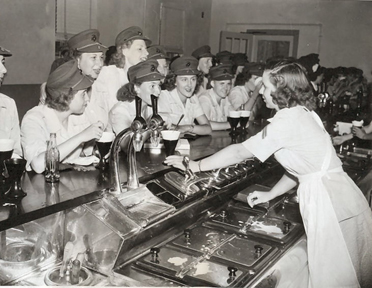
The Women's Army Auxiliary Corps (WAAC) at Ease
...the soda jerk is a coropral
Click to Enlarge
Doughnuts and coffee were good, but girls were the main event.

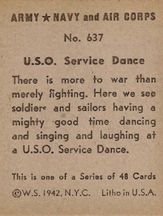
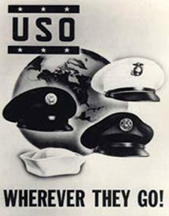
Dancing Was the Principal Attraction at the USO
...even in Trading Cards Collected by Kids
Click to Enlarge
The 48 card set, 'Army-Navy-Air Corps' is of great interest to card collectors, especially for the wartime propaganda on the back. It was issued in 1942 by the W.S. Company; cards can sometimes be found still attached to one another in strips, and these are considered more valuable. The Burdick Catalogue number is R18
Because Wurlitzer had access to a large number of machines under lease, they were able to ship jukeboxes (especially older ones) all over the world, setting the stage for an enormous increase in international business at war's end. Here are some Office of War Information (OWI) photos showing: (a) A Wurlitzer Model 500 (c. 1938) in a 1944 USO Club and (b) a Wurlitzer Model 616 (originally made in 1937) doing duty in a USO Canteen in 1943.
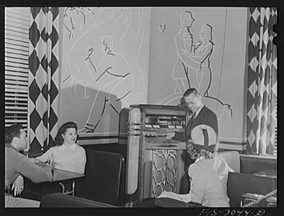
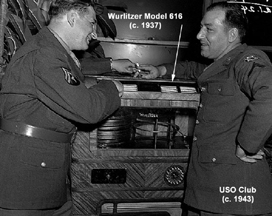
The Omnipresent Jukebox at the USO
(left) Model 500 (right) Model 616
Nothing but the best dead stock for our boys...
Click to Enlarge
Here are two photographs from OWI showing a Wurlitzer Model 750 in a segregated facility, entertaining African-American troops.
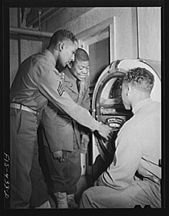

Wurlitzer Model 750 Jukebox Entertaining African-American Troops
Everything was segregated in the US Army in World War II
Circa 1944
Click to Enlarge
After the war, Wurlitzer, like other companies, struggled with materiel and skilled labor shortages. Howver, the introduction of the now classic Model 1015 jukebox in 1946 restored the company to pre-eminence in the jukebox field. Fifty six thousand 1015s were sold in less than two years. The company was, however, resting on its technological laurels because it continued to use the 1930-era Simplex changer mechanism that was limited to playing one side of a record, and for practical purposes, limited to 24 selections. The peak of Wurlitzer's fame came in 1949 with the bullet-nosed Model 1100.
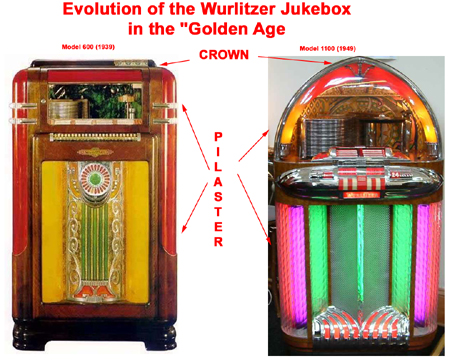
Wurlitzer's 20 Years at the Top
The beginning and the end of the famous line of jukeboxes...
Click to Enlarge
Wurlitzer was also a player in the wall unit business. The industry hypothesized that the customer would be much more likely to part with his nickels if he could make choices right at his table without getting up and walking to the box. This proved to be a major technical challenge and, as we'll see below, other companies were more adept in creating these "wallbox" systems. Here is a retrospective of Wurlitzer's efforts in this field. The series begins with the Model 5010, which simply allowed the customer to insert change and play the "Top Ten Tunes" for half a dollar. A fifty cent piece was required.
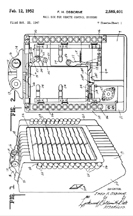
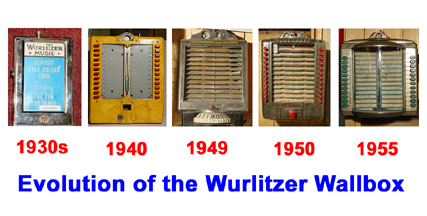
Wurlitzer's Experiments in Wall Boxes
Wurlitzer remote unit Patent No.2,585,401
Click to Enlarge
Click here if you want to learn how to get Patent Drawings
Wurlitzer had one unique device, called the "Bar Box." This was a remote station in a compact package that could be placed on the bar without taking up an inordinate amount of room. This provrd to be popular with tavern patrons
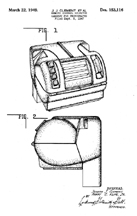
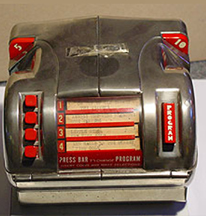
Wurlitzer Bar Remote Control
Patent No. D-153,116
Click to Enlarge
Click here if you want to learn how to get Patent Drawings
The company's fortunes declined because they were blindsided by the recording industry's move to the smaller 45 rpm record and because they were not as innovative in mechanical design as they were in exterior decor. In 1949, Seeburg introduced a breakthrough record changer that offered 100 selections (instead of 24) and would handle 45 rpm records; by doing so, they quickly overtook Wurlitzer and dominated the jukebox market. Of all things, Wurlitzer's response was to lease older jukeboxes to places that would have been declasse in the 1930s -- drug stores, malt shops, diners and the like. Thus, the Model 1015, originally intended for the cocktail lounge crowd, found itself smack in the middle of the 1950s newly empowered consumer: the American Teenager. For this reason, the Model 1015, technologically obsolete and over-adorned in the "less-is-more" aesthetic of Danish Modern, found its way into the hearts and pocketbooks of a whole generation. Rock and Roll and the 1015 are almost inseparable, both then and now. The Wurlitzer is often used as a prop to invoke the 1950s in period films and television.
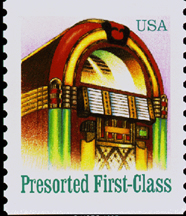
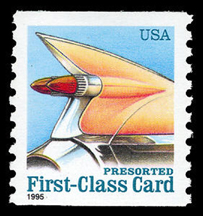
Icons of the 1950s
Wurlitzer Model 1015 Jukebox and the Tailfin of the 1959 Cadillac
Click to Enlarge
Catalog Reference: The Jukebox Stamp is Scott 2911 and the Tailfin Stamp is Scott 2908
The stamp was intended for use by business mailers who presort their mail. The jukebox stamp originally cost 25 cents and the tailfin stamp cost 15 cents.
The Wurlitzer name was still synonymous with jukeboxes, although jukeboxes were hard pressed to deal with the times when America basically stopped dancing. Drugstores, Diners and malt shops all but disappeared. In the 1970s, the remnants of the Wurlitzer company were purchased by Gibson. In the 1980s, a renewed interest in the 1950s era led to the resurrection of the Wurlitzer 1015 jukebox. In 1986, in order to celebrate the 40th anniversary of the 1015 Gibson produced an exact replica, calling it the "One More Time". This new jukebox had the design of the classical 1015, but with the latest technology of a modern jukebox. In 1995, the U.S. Post Office issued a new stamp commemorating the 50th Anniversary of the Wurlitzer 1015 jukebox. Replicas of all the famous Wurlitzer jukeboxes of the 1930s are now manufactured in Germany. There is an extensive Wurlitzer Museum in North Tonawanda, New York.
for the Wurlitzer Model 1100!
Here is the Table of Contents:
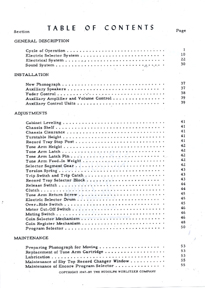
Click to Enlarge
The Service Manual:
- What's New About the Model 1100?
- Cycle of Operation
- Electrical Selector
- Electrical System
- Sound System
- Installation
- Adjustments
- Maintenance
- Oversized Schematics (pp 25,33,34,35)
The Parts Catalogue:
- Illustrated Parts Catalogue, Part 1
- Illustrated Parts Catalogue, Part 2
- Illustrated Parts Catalogue, Part 3
- Illustrated Parts Catalogue, Part 4
- Numerical Parts Catalogue
The Automatic Music Instrument Company (AMI)
AMI began in 1909 as the National Piano Manufacturing Co, selling player pianos with a mechanism that allowed a customer to select music rolls to be played. The company adapted the mechanism to select and play phonograph records and went into the jukebox business in 1927 as ""National Automatic Music Company". The mechanism used was the first that could play both sides of 10 records, allowing 20 selections. Also, AMI was the first to use electrically amplified sound. Aside from modifications to extend the number of selections, the same changer was used for the next 30 years.
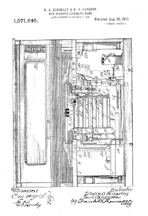

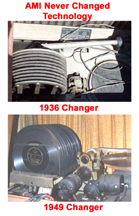
AMI Tecnical Underpinnings
Automatic Player Piano Patent No. 1,071,640
AMI Changer Patent No. 1,590,654
AMI Used the Same Changer Technology from 1936-1949
Click to Enlarge
Click here if you want to learn how to get Patent Drawings
During the Depression, the company manufactured a number of Art Deco styled jukeboxes, most noable the Streamliner. Perhaps the most unusual looking jukebox ever made is the AMI Singing Towers produced between 1939 and 1942. The design of moulded glass, stone effect finish and a top light was influenced by New York skyscrapers and was the first to change the colors of the lights as music played. There were also innovations in sound quality. From 1939-1942, this jukebox was sold and serviced by operated by an affiliate of AMI, Singing Towers Inc. Unfortunately this design was never a major commercial success due to mechanical problems.
During the immediate pre-war period, AMI also experimented with remote control wall units to allow the customer to select music without leaving his table. In 1939, AMI introduced the Mighty Midget units that were well received by establishments with limited seating space as found in the big cities.
During World War II, AMI ceased production of Jukeboxes,and produced electonic equipment for the armed services. At war's end, AMI retained the services of Jean Otis Reinecke, the famous industrial designer who had achieved significant fame for the Hamilton-Beach Milk Shake Mixer and the iconic Toastmaster Toaster, as well as lesser masterpieces (below).
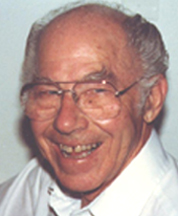
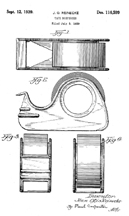
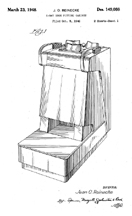
Jean Otis Reinecke
Scotch Tape Dispenser Patent No. D-116,599
The Infamous Foot X-Ray Machine, Patent D-149,088
Click to Enlarge
Click here if you want to learn how to get Patent Drawings
In 1946, the name of the company was officially changed to AMI Inc. and the company introduced the AMI Model A, also called Mother of Plastic, designed by Reinecke. In 1948, the AMI Model B was introduced as a lower cost alternate to the Model A. The next model, the AMI Model C was introduced in 1949. Both models B and C were not design patented. In the 1950s, AMI moved to a new changer system and introduced the Model D tha was capable of playing 45 rpm records.
During the 1950s Licensed manufacturing agreements created BAL-AMI (England), IMA-AMI (Denmark) and EDEN-AMI (France). The Automatic Canteen Company bought AMI in 1959, merging it with its subsidiary ROWE AC Services, a manufacturer of coin operated vending machines. Rowe-Ami is still manufacturing jukeboxes today.
The Seeburg Corporation
The Seeburg Company was founded in 1887 and eventually came to dominate the jukebox field in the late 1950s. The company attained its position through superior technology.
In 1887, at the age of 16, Justus P. Sjoberg left Sweden, bound for the United States. He changed his name to Seeburg soon after arriving in Chicago. After completing an apprenticeship in the Smith and Barnes piano factory, he started his first job at the Markette Piano Company, then moved to the C. S. Smith Piano Factory and eventually became plant superintendent at the Cable Piano Company. At this point, he became involved with renting coin-operated player pianos, which were all the rage. After building up a considerable client base, he formed his own company. The demand for electric piano players was strong and Seeburg eventually occupied sales office and display rooms in the fashionable Republic building in Chicago's loop. (By the way, the "P" in Mr. Seeburg's name stands for "Percival")
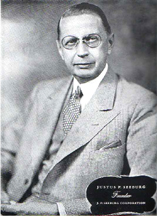
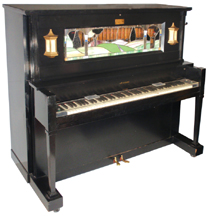
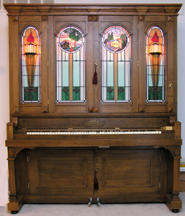
Justus Percival Seeburg
Coin Operated Piano and Orchestrion
Click to Enlarge
Always an innovator, Seeburg supplemented his line of coin-operated electric piano players with the Orchestrion, that used piano roll technology to play piano, violin, mandolin, flute, snare drum, cymbals, triangle and other percussive effects. Here is a video that shows "Charleston" being played on such a machine (dance along if you wish.)
In 1926 the availability of electrically recorded records and the development of amplified sound led to a growth in the market for recorded music. The Brunswick 'Panatrope' was the first all-electric home phonograph and it became clear that the home and public markets were moving away from piano players. In 1927 the 'Orchestrion' was discontinued and the Seeburg Company developed their first phonograph. The Melatone jukebox was a complete failure because it had a habit of fracturing the records. I'd like to show you a picture, but all of the machines, approximately a hundred, were recalled and destroyed.
Undaunted, Seeburg introduced the "Audiphone", an eight selection jukebox that worked by means of a pneumatic Ferris-wheel. Although it was simple and reliable, the Ferris-wheel mechanism required a very wide machine case was. Although Seeburg often lost out to other companies on the basis of floospace, production of the Audiphone continued into the 1930s.
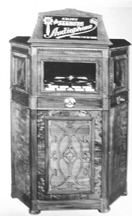
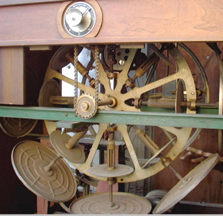
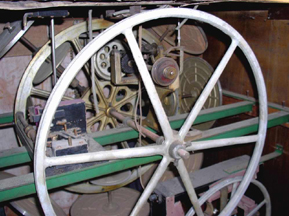
"Ferris Wheel" Playback on the Seeburg Audiphone
Circa 1928
Click to Enlarge
Seeburg was not immune to the Depression and fell into receivership in 1931. The company diversified its offerings based on its experince with coin handling mechanisms. They adapted their coin systems to many other sectors. They adapted existing machines (e.g. clothes washers) to coin-operated capability and began to produce games and vending machines. You may see a Seeburg "Fruit-o-Mat" in the film in the film The Girl Can't Help It -- the machine is located in the recording studio. There is also a Seeburg Model S-147 "Trashcan" jukebox in a previous scene. It is of some ironic note that the subtext of this film is a rivalry between "Fats" Murdock and "Legs" Wheeler, supposedly "reformed" gangsters in the Slot Machine/Jukebox industry. Apparently, the Wheeler enterprises use Seeburg Model 147s while the Murdock gang uses Seeburg Model 100A machines. Regrettably, there are several scenes where S-147s are destroyed. It appears that Seeburg was the principal supplier of jukeboxes for the film.
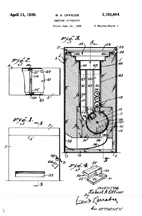
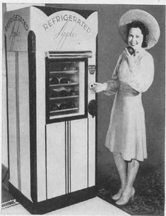
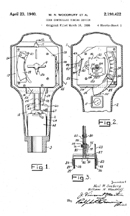
Seeburg's Adventures in Vending
Frozen Confection Vending Machine, Patent No. 2,153,694
Refrigerated Apple Vending Machine
Seeburg Parking Meter Patent No. 2,198,422 Click to Enlarge
Click here if you want to learn how to get Patent Drawings
Developing cigarette vending machines, cold and hot drink dispensers, parking meters and the like kept the creditors away. By 1934 the company was debt-free and began to dabble in jukeboxes with the Selectophone. This time, they used a changer designed by Russell Wilcox who had done wonders at Wurlitzer. Instead of bringing records to the tonearm, this changer had a two inch gap between the records and the tone arm was brought to the record. This ingenious device offered the promise of selections limited only by the height of the box. Alas, this change was defeated by the simple fact that records warp and in doing so interfered with the tone arm resulting in jams, especially in summer's heat. This jukebox was also a failure.
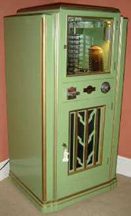
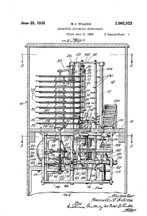
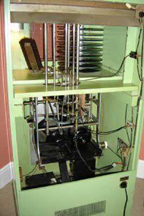
The Failed Seeburg Selectophone
Wilcox Movable Tone Arm Changer Patent No. 2,005,923
Click to Enlarge
Click here if you want to learn how to get Patent Drawings
By this time the 60 year old Justus handed the reins of the company to his son Noel Marshall Seeburg, although he remained active in company affairs until his death in 1958.
N. Marshall Seeburg had been brought up around the electrical innovations of his generation and the company received a much-needed shot in the arm. The new director in turn brought in new talent: M. W. Kenney, an engineer, Nils Miller, an industrial designer and Henry Roberts, sales manager. In the mid-1930s, Meyer Parkoff moved over to Seeburg from Wurlitzer, beefing up the company's distribution arm. At the 1938 Jukebox Convention in Chicago Seeburg unveiled a new machine called the "Symphonola". Miller had been experimenting in translucent plastics for the casing. The plastic panels had low wattage bulbs behind them,that made the box "glow". The Symphonola "Crown" was probably the first jukebox to use plastics, although Wurlitzer had also been experimenting with lighting effects during the same period.

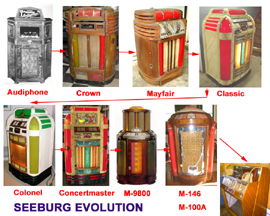
N.M. Seeburg and the Evolution of the Seeburg Jukebox, 1927-1950
Models shown represent "lines" -- each line had upscale and downscale variants
Click to Enlarge
The various different models of 'Symphonola' including the Crown,Casino, Classic, Colonel, Commander, Hi-Tone, and the Model S-146,the last being affectionately known as the "Trashcan". All of these product lines and their variants are discussed in detail in our Aesthetics of the Jukebox page. Seeburg was at the forefront of new technology including key experiments in providing high quality sound. However, they were never quite able to keep up with their competitors. One major problem with the Seeburg machines is that the customer could not see the record changer. Amidst all the high technology (for its time) the Seeburg designers missed the obvious entertainement value of the changer. Without animation, the Seeburg jukeboxes were just furniture. This was probably the earliest demonstration of the value of "User Friendly" in electronic commerce.

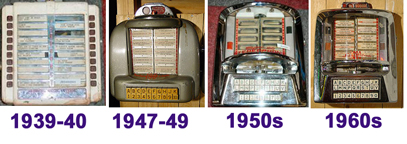
Evolution of the Seeburg "Jukebox Wallbox", 1940s-Current
Patent for Seeburg Jukebox Remote Control, No 2,378,653
Click to Enlarge
Click here if you want to learn how to get Patent Drawings
AS we have hinted in the discussion of jukebox economics, all the major manufacturers sought to increase revenue by bringing the selector ro the customer. This was done through units mounted at each table, saving the customer trips across the crowded dancefloor to insert his nickels. In 1939 Seeburg got into this game with the "Wall-O-Matic", a wall box communicating to the master phonograph using a thick twenty-wire cable (one for each selection.) Selections were sent to a central machine used radio frequency signals. At this time, the Seeburg jukeboxes acquired military rank (Colonel,Major, etc.) to emphasize that they were capable of "commanding" a network of remote locations.
Telephone Jukeboxes
As we have noted in our Jukebox Mechanics page, the size of the changer more-or-less dictated the volume of the cabinet. About 20 records was the limit if the box was to fit into a reasonable space and have simple enough mechanicals to be reliable. Some executives (most notably Homer Capehart) could not believe that customers could deal with more than 20 selections. Bill ("64K is enough") Gates was to make a similar gross underestimate nearly 40 years later. There was some truth to the "20 is Enough" philosophy as illustrated by the Telephone Jukebox in which fifty jukeboxes were linked by telephone lines to a central station where female "disc jockeys" would take requests. Although selection was theoretically infinite, most setups had about 250 titles in addition to the 20 on the "local" phonograph. An actual "Telphone Jukebox" facility was shown in the grade B- film The Crime Doctor's Diary, a spin-off of the popular Crime Doctor radio series. Here are some stills from that film showing the bank of turntables, a closeup of an individual turntable and the unit in the retail location.
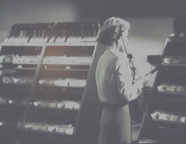
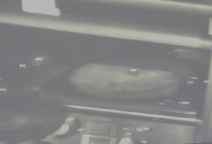
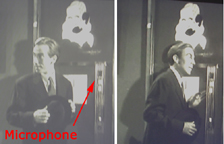
Hollywood Representation of a Telephone Jukebox Setup
Fran Valentine is the "Operator" and Whit Bissell is the fellow requesting the song
Click to Enlarge
One of the sub-plots of the story is a rivalry between a jukebox company and the phone DJ system. In reality, the phone-based system never caught on, and many industry leaders concluded that twenty selections was all people really wanted. Seeburg was only a minor player in Telephone Jukebox, and we're going to cover this topic in depth (below) in the section on the dominant telephone juke player, the Rock-Ola Company.
Like most factories during the Second World War, Seeburg went into the development and production of electronic equipment for the US Armed Forces. This total conversion to war work continued to the end of World War II and brought the company three Army- Navy "E" (for excellence) Awards. (Wurlitzer only got one.) Seeburg did not have an invetory of machines and lost out on the demand for placement in military establishments. Defense contracts got the company through the war, and by all accounts, the Seeburg company served the country well.
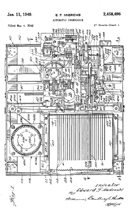
Edward Andrews M100 Changer Mechanism (Top View)
Patent No. 2,458,496
Click to Enlarge
Click here if you want to learn how to get Patent Drawings
In the period immediately after the war, Seeburg continued to produce the various "Symphonola" models shown above. In 1945, Edward Andrews joined the firm and developed a radically new mechanism that could be adapted to play a very large number of records. In 1948, Seeburg unveiled the Model 100 A (or Selectomatic) and revolutionized the jukebox market by offering 100 selections. In the period 1945-1955, Americans discovered the "magic" of quantity -- they wanted bigger products and more selection. The emergence of a teen market resulted in musical taste fragmented along generational lines. Since bigger was better, 20 jukebox selections was no longer enough, and Seeburg was the only company ready to satisfy the market. From 1950 on, Seeburg dominated the jukebox market by technological innovations. They were among the first to adapt to 45 rpm records, they introduced the M200 with 200 selections; they left the arch and curves of the 1940s behind for jet-age modern machines with straight lines and chrome fixings. Finally, Nils Miller put the intriguing new changer mechanism on display under a transparent plastic dome. This was Seeburg's most successful era.
Over the ensuing years improvements and modifications were made to Seeburg's machines, and they remained the industry leader for some time. In 1953 they introduced high fidelity reproduction, with phonograph model HF100G, a wide-range, multi-speaker instrument with low distortion. Two years later came the first 200 selection jukebox, which also came with another ground-breaking innovation - the electronic memory unit, which was used to "remember" and then play multiple selections. Seeburg had an active corporate life until the 1980s when a series of mergers, acquisitions and the like expanded the company's business lines to include vending machines, musical instruments and satellite broadcasting.
The Rock-Ola Company
This was a dynamic company headed by an energetic and innovative Canadian named David Collin Rockola. His work began in the 1920s and included all kinds of mechanical devices including parking meters and motor scooters.
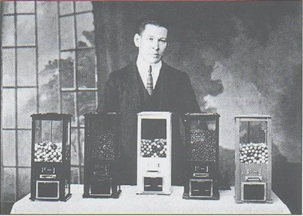
David C. Rockola and Bubble Gum Machines
The Rockola Company was manufacturing jukeboxes long before the Rock'n'Roll era
Click to Enlarge
The company name "Rock-Ola" is not a portmanteau as "victrola" is a combination of "Victor" [Talking Machine] with "Pianola" [musical instrument.]
Rockola was Russian, not Italian as many assume. His father, George, a blacksmith turned inventor (developing and patenting a double-stroke pump in 1906) immigrated to McCauley, Canada from Byelorussia in the 1890s. Rockola’s industriousness and determination were exhibited at an early age. While living with his mother, Sarah (then separated from his father) in Virden, Canada, young David and three of his four brothers built the house they lived in. At age 14, David left home after his mother died and worked his way through several Canadian cities. He worked as a mechanic in a vending machine factory.. It was not higher education but skills acquired on-the-job that enabled him to do wonders with machinery. At the age of 23 Rockola moved from Manitoba to Chicago and started a small dealership in coin-operated scales. These "Penny Scales" were a very popular novelty and soon David started making them as well as sellling them. He did well at both aspects and soon the Rock-Ola Scale Company was a thriving enterprise.
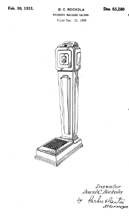
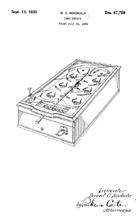
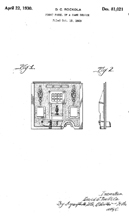
Evolution of Rockola Business from Scales to Slot Machines
Scale: Patent D-83,280; Pinball Patent D-87,759; Slot Machine, Patent D-81,021
Click to Enlarge
Click here if you want to learn how to get Patent Drawings
Rockola noted that the Pinball machines he encountered when placing his scales were very popular. Soon Rockola began manufacturing them as well. Unfortunately, his game (called "juggleball") was introduced just as the Depression hit. Like others in the coin operated machine field, Rockola felt the pinch of hard times and soon found himself deeply in debt. In a masterpiece of negotiation Rockola managed to persuade his backers to continue with the company. According to the official company history, "..In the next three years the Rock-Ola company restructured to sell coin-operated games, and Rockola paid back his investors..." Unfortunately, these "coin operated games" were slot machines, and David Rockola was tainted with ties to organized crime. [We will treat the subject of jukeboxes and crime in a section below, since all manufacturers were involved to some extent]
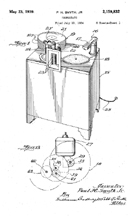
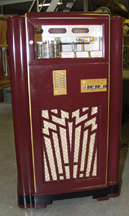
The Paul Smyth Changer and the Rock-Ola Model A Jukebox
Patent No. 2,159,832
Click to Enlarge
Click here if you want to learn how to get Patent Drawings
In 1934, Rockola left Chicago [one step ahead of the sheriff, see below] and relocated in California. At this time, he began to manufacture coin-operated phonographs after meeting Paul Smyth, an engineer with a novel concept for a record changer. Rockola bought the patent and went into jukebox production. The model A, introduced in January 1935, was the Rock-Ola company's first twelve-selection jukebox. Some work on the mechanism increased the selection to twenty by 1937, and this number would stay the same until 1950.
Rock-Ola's design ethic was a large contributing factor to their success. David Kochole designed most of the beautiful jukeboxes produced by Rock-Ola during the "Golden Age". However, you will not see Kochole's name on any of the patents. David Rockola was very determined to hang on to all the patents himself. This focus stemmed from an intense personal rivalry with Noel Seeburg, Homer Capehart, and Farny Wurlitzer. According to most sources, Seeburg and Wurlitzer made Rockola "an offer he couldn't refuse", arguing that the jukebox market was saturated, and there was no room for his company. The big firms offered to give Rockola a dominant position in the coin operated games business if he left jukeboxes. After dealing with Chicago organized crime, he probably wasn't that worried. Rockola's precise reply is unknown, but one can assume that it was a polite decline, possibly followed by a hand gesture. The fact is that Rock-Ola captured and maintained its niche in the jukebox market through exceptional artistic and technological achievements. Rockola's designers always managed to stay in touch with the "zeitgeist". In the late thirties and early forties their jukeboxes were luxury light up models, covered with marbellised plastics and coloured lighting effects. Despite the rationing of metals and plastics during the war, Rock-Ola were able to come up with some of their most unusual and interesting designs, especially in the area of high fidelity sound. The "tone column" series ("Spectravox" and "Commando" ) used an upward-pointing speaker to distribute sound across the room.
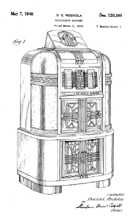
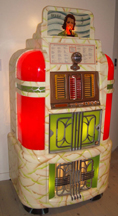
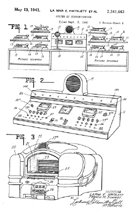
Telephone Jukebox Technology
Rockola Telephone Jukebox Design Patent D-120,398
Rockola Mystic Music Jukebox
Wurlitzer Telephone Jukebox Scheme, Patent No. 2,241,663
Click to Enlarge
Click here if you want to learn how to get Patent Drawings
During the 1940s, Rock-Ola did outpace Seeburg and Wurlitzer in one small area -- the "Telephone Jukebox." In order to increase the number of selections, about fifty jukeboxes were networked to a central station. Ladies with euphonious voices would receive a customer's request, made by speaking through a mouth-piece in the machine and play it via a direct telephone line connection to the box. Theoretically, the number of selections was limited only by the size of the record library at the central station. Wurlitzer and Seeburg dabbled in this market but Rockola had the dominant number of spots mainly in New York and Los Angeles. The Rock-Ola Mystic Music jukebox even plays a small role in the film It's A Great Feeling. In the film, Doris Day plays a music operator who learns that a Hollywood producer is on the line. Instead of playing the song he requested, she sings the song herself. (The film never quite explains where the background music came from...) In the end, Doris becomes a big star, as if you couldn't guess.

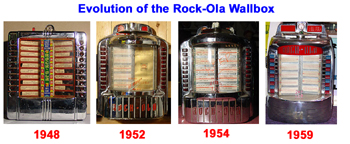
Evolution of the Rock-Ola Wall Unit Line 1948-1959
Original Design patent D-167,953
Click to Enlarge
Click here if you want to learn how to get Patent Drawings
Rock-Ola was also a player in the remote control wall unit juke box business. Both the "Spectravox" and "Commando" lines were specifically engineered to be used with remote wall units. Seeburg outpaced Rock-Ola and Wurlitzer finished third. By 1960, Rock-Ola and Seeburg dominated the market. Clearly the wave of the future was technology, particularly that which enabled a large number of selections. Rock-Ola finally outdid Seeburg with the Rocket,Comet and Tempo series, all of which had cabinets that appealed to teenage fantasies of Space Travel and Fast Cars. Notice the curved glass "nose cones" and the pseudo Cadillac "V" grille on the front of the Tempo.
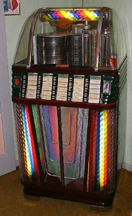
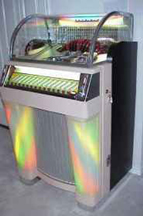
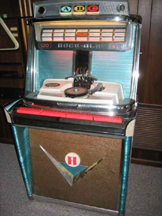
Rockola Jukeboxes of the 1950s
(left to right) Rocket, Comet Fireball, Tempo
Space and Car Themes
Click to Enlarge
Rock-Ola's success is best attributed to the drive, intelligence and resillience of David Rockola. His success in a competitive industry was galvanised by the pressure put on him by his rival companies. As a late entrant into the world of jukebox production, Rock-Ola overcame hostility and ruthless competition by a combination of technological know-how and up-to-date design that made the company a success.
The Mills Novelty Company
The Mills Novelty Company is best known for slot machines, vending devices, and Penny Scales, but they also had some presence in the world of jukeboxes. In this section, we're going to take a brief look at Slots and Vending Machines, because they illustrate the Mills company forte -- coin handling.
The business was started by Mortimer Birdsul Mills, who was born in 1845 in Ontario, Canada. Eventually, he emigrated to Chicago and became an American citzen. Mills had 13 children and lived in Oak Park, Illinois, just outside the city. This was a family business and many of his children came to play key roles in the company.
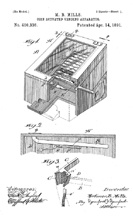

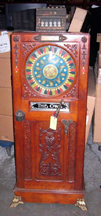
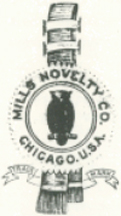
Products from the Mortimer Mills Era
Original Vending Patent No. 450,336
Brochure Touting the Virtues of the MBM Cigar Machine
The Mills Owl Gaming Machine
The Mills Novelty Corporate Logo Featuring the Owl
Click to Enlarge
Click here if you want to learn how to get Patent Drawings
Mortimer Mills was granted United States patent 450,336 on 14 April 1891 for an improvement in "coin-actuated vending apparatus". The improvement allowed the purchaser to "select the product being sold and manipulate it so that it was carried to the point of delivery." Based on this patent, Mortimer Mills founded the M.B.M. Cigar Vending Company in 1895. On the success of the cigar vending machine, the company began manufacturing and distributing the Mills Owl the first mechanical upright cabinet "gaming" machine. This machine had an element of chance -- However, it was left to the establishment to make payments according to a schedule affixed to the machine. The design included a circle of owls perched on a lithographed tin wheel. The machine was a great success and the company adopted an owl motif as its trade mark. In 1898, Mortimer Mills sold a controlling interest in the company to his eldest son, Herbert S. Mills who changed the name of the company to Mills Novelty Company. At that time, the company was located at 125-127 West Randolph Street, Chicago. In 1904, Mills Novelty Company was an exhibitor at the Louisiana Purchase Exposition in St. Louis, Missouri. (this was the setting for the film Meet Me in St Louis.

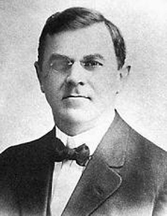
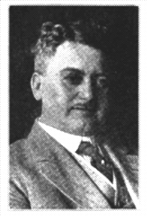
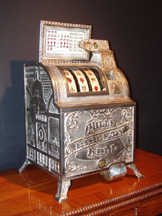
The Mills Company and Slot Machines
Williams 1898 Game Patent No. 495,285 (Looks like a Liberty Bell)
Charles Fey, Father of the "One-Arm Bandit" Slot Machine
Herbert Mills, Entrepreneur -- a well-dressed, sly looking fellow
The Mills Liberty Bell Slot Machine
Click to Enlarge
Click here if you want to learn how to get Patent Drawings
SLOT MACHINES: Most contemporary sources hold that a Bavarian immigrant named Charles Fey invented the "One-Armed Bandit" slot machine in San Francisco. This was the first machine to make automatic payments for a pre-determined sequence of outcomes. As such, it was much more popular with bar and saloon owners because it took care of itself. Fey made a small fortune by splitting the proceeds 50/50 with the barkeeps. The Mills official history implies that in 1907, Herbert S. Mills "collaborated" with Charles Fey, to produce the Mills Liberty Bell. The same contemporary sources hold that Fey was unable to keep pace with demand for slot machines and that the Mills company produced a look-alike. The San Francisco earthquake of 1906 wiped out Fey's factory and equipment and he was forced into partnership with the Mills company. The "Liberty Bell" machine was so named because the big jackpot was paid when three bell symbols lined up in the game windows. The contribution of the Mills company seems to have been the use of fruits (cherries, lemons, grapes) as symbols on the spinning wheels. Our research has, however, turned up an "Automatic Gaming Device" (Patent Office euphemism for gambling device) invented by R.S. Williams that is in the actual shape of the Liberty Bell. For whatever reason, this imagery persisted, and all Mills slot machines were manufactured by a subsidiary called the Bell-O-Matic Corporation.


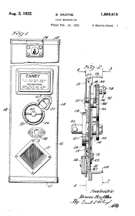
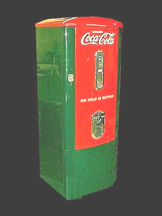
The Mills Company and Vending Machines
1906 Punching Bag Machine
Mills Novelty Engraving Machine
Bruno Radtke Coin Handling (and Changing) Patent No. 1,869,616
The Mills Model 45 Coca-Cola Machine
Click to Enlarge
Click here if you want to learn how to get Patent Drawings
VENDING MACHINES: Mills would distinguish itself by being one of only a few firms to manufacture bmachines for both gambling and vending. As we have seen, the link between the two is coin handling, a specialty at Mills. By 1910, the company was making elaborate cast iron machines that sold chewing gum, peanuts, and candy. They also had a variety of amusement devices such as a punching bag machine, a weight lifting machine, a film viewer, fortune telling devices and a gadget that engraved a metal name-plate. click here to download a ".pdf" of the Mills Catalogue for 1906 to see and read about all these wonders. Mills made great progress in vending almost everything. After they had acquired the significant coin handling patent developed by Bruno Radtke (1931) they were now able to make change for purchase. This stimulated great interest and gave them a virtual lock on the business. In 1935, Mills was engaged by Coca-Cola to produce a vendor that incorporated refrigeration. The result, models 45 - 47, was the first of its kind for Cola-Cola, and became the iconic "Coke Machine". The vending division was spun off to a subsidiary called Mills Automatic Merchandising Corporation of New York. Herbert's brother Bert E. Mills was involved in the vending business and is credited with inventing the first vending machines to sell hot coffee.
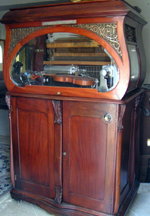
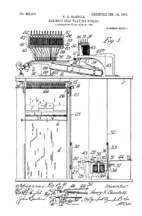

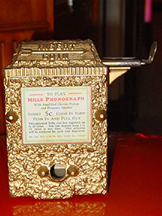
The Mills Company and Coin Operated Music
The Violano-Virtuoso Automatic Violin Player
Henry Sandell Patent for the Violano No. 807,871
Mills Coin Operated Radio-Phono Patent No. 1,968,499
The Mills Remote Control for Radio-Phono
Click to Enlarge
Click here if you want to learn how to get Patent Drawings
JUKE BOXES: Between 1905 and 1930, the company's products included the Mills Violano-Virtuoso, machines that automatically played a violin They were also involved with player pianos. In 1928, Mills entered the market for coin-operated radios and multi-selection phonographs with a gadget that just tacked a coin handler on to either an existing radio or phonograph. Of note, this was probably the first "Remote Unit".
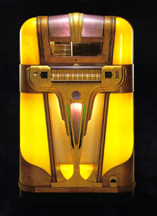
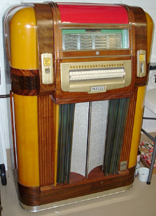
The Mills Company Jukeboxes
Mills Empress Jukebox
Mills Throne of Music Jukebox
Click to Enlarge
Click here if you want to learn how to get Patent Drawings
Between 1929 and 1948, the company manufactured and sold jukeboxes by the names of Hi-Boy, Troubadour, Dancemaster, Do-Re-Me, Swing King, Zephyr, Studio, Throne of Music, Empress, and Constellation. Most of these machines are only "adequate" by technical and aesthetic standards. Generally, Mills followed the trends and used its contacts for slot machines to place jukeboxes. The Empress is the most desirable of the lot. Mills was an early dabbler in the wall unit race, and developed a remote unit that did not have selection.
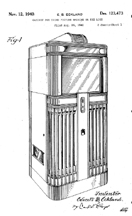
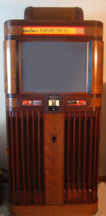
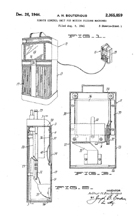
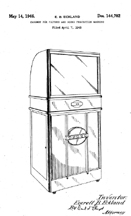
The Mills Company Panoram
Everett Eckland Design Patent D-123,473
The Beautiful Panoram!
Arthur Bouterious Remote Control Patent No. 2,365,859
Eckland 1945 Sono-Vision Design D-144,702
Click to Enlarge
Click here if you want to learn how to get Patent Drawings
Mills' greatest contribution to music was indirect through its motion-picture jukebox, the Panoram. Mills was the dominant force behind these big audio/visual machines during the the 1940s because (after decades of experiments) they developed a reliable reel operating mechanism. As shown above, the Panoram was the size of a refrigerator, hosed in an attractive Art Deco cabinet designed by Everett Eckland. The technology used a series of mirrors to reflect the image from an RCA projector onto a 27-inch etched-glass screen. The machines first appeared in 1939 and found their way into countless soda shops, taverns, bus and train stations, and other public places across the nation. The specially-made 16mm films held 8 musical numbers and ran in a continuous loop. A foil strip embedded in the film was the demarcation between segments. Each loop of the tape cost the patron a nickel (eventually a dime). For technical reasons the prints themselves were printed in reverse as the confined space inside the Panoram machines required a complex series of mirrors in order to project the image on to the inside of the screen. The machines could be operated at the box or from remote stations designed by engineer Arthur Bouterious. One major flaw in the technology was that in order to play, say, selection number eight, you had to sit through numbers one to seven first. Initially, the Panoram was a great success and found its way into thousands of bars, hotel lobbies, bus stations, restaurants, etc. across the country. In 1940, there were nearly 10,000 Panorams operating.
Here is a good example of a "Soundie" because it features jukeboxes -- although the machine in the clip was made by the Seeburg Company, Mills' arch-competitor. Thanks to our friend Dave, we have identified it as the "Colonel" model.

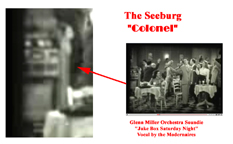
The Seeburg "Colonel" Featured in the Panoram Soundie shown below:
This is the Glenn Miller Orchestra doing Juke Box Saturday Night
Vocal by the Modernaires
Click to Enlarge
THE SOUNDIES: The16mm film with sound tracks used in the Panoram were officially called Soundies (one reel with 8 film clips was released per week). The Soundies were made by RCM Productions, an acronym for the names of James Roosevelt, songwriter Sam Coslow, and o Fred L. Mills. (Yes, James Roosevelt was the son of President Franklin D. Roosevelt.) The films were distributed by The Soundies Corporation of America. The Soundies were churned out cheaply and fast but they featured many of the popular entertainers of the time. The machines were popular, but several external events caused trouble. First, James Roosevelt left the firm to serve as the well-decorated leader of a commando battalion in the European Theater. Second, during 1942-1943, the American Federation of Musicians imposed a nationwide ban on new recordings forcing the anxious RCM producers to call upon all their ingenuity to maintain the Soundies production schedule - some 50 titles per month were required. Finally, the Film Projectionist's Union did their best to harass the Panoram. Despite these three impediments, the Soundies are still invaluable film records of musicians, including Duke Ellington, Jimmy Dorsey, Fats Waller, Count Basie, Nat King Cole, the Mills Brothers and others. The rock bottom production values of the Soundies leave much to be desired. The music in Soundies was almost always recorded first and the artists would then mime on camera to playback with varying degrees of professionalism.
During World War II, Mills received authorised federal funding to use its industrial facilities to produce bomb carriers, directional antenna, hand control slip rings, and poppet valves. After the war, Mills experienced many financial problems, mainly due to the shortage of materials and the end of the Soundie craze. By 1946 only about 2,000 machines were still on location and problems with the film projectionists' union continued. Today several of the Mills (Model MI-1340) Panoram machines are known among collectors and museums, and they are certainly not as unpopular today as they were among film projectionists in the mid forties. Eckland designed another audio/visual machine in 1945, but for Sono-Vision, a short-lived re-packaging of the Mills assets. It was not coin operated.
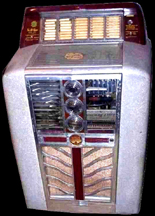
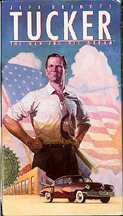
The Mills Constellation Jukeboxes
The End of the Line
The Center Medallion was the Horn Button in the 1948 Tucker
Click to Enlarge
The last jukebox produced by the Mills Novelty Company was the Constellation (model number 951). By a complicated series of events the front grille medallion from the 951 morphed into the horn button for the 1948 Tucker Sedan.
The Mills corporation was largely defunct by 1949.
The Packard Company
This was NOT the company that made fine automobiles, but the creation of Homer Capehart who has been acclaimed by some as "the father of the jukebox industry." Others, like Harry Truman thought of him as a royal pain in the butt. He was a shrewd judge of the popular music market, a very effective administrator and a right-wing U.S. Senator. Homer Capehart was no ordinary man.
Homer Earl Capehart (June 6, 1897 - September 3, 1979), was born in Algiers, Indiana. During the First World War, he served as a Sergeant in the United States Army Supply Corps, but was never sent overseas. From 1919-1928, he held a variety of jobs selling milking machines, tractors, plows, and popcorn poppers, finally working his way up to sales manager for Holcomb and Hoke Manufacturing Company in Indianapolis, Indiana. He founded the Capehart Automatic Phonograph Corporation of Fort Wayne in 1927. This company manufactured coin operated machines and home radio-phonographs under the name Amperion.
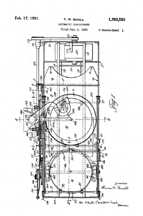
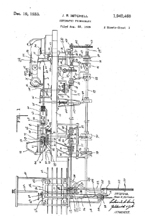
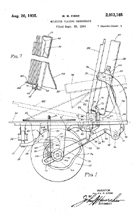
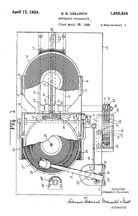
From 1928-1930, Capehart Acquired Numerous Automatic Changer Patents
Small Changer Patent (1928) No. 1,792,553
Mitchell Changer (1928) Patent No. 1,840,460 Erbe Changer (1929) Patent No. 2,012,185
Collison Changer Patent (1930) No. 1,955,534
Click to Enlarge
Click here if you want to learn how to get Patent Drawings
As shown above, Capehart purches a number of patents for automatic record changers. He was forced out of the company by investors in 1931 after the Smalls record changer had a disastrous failure. The home appliances (Amperion) division was purchased by Philo Farnsworth the inventor of Television. In 1932 Capehart formed the Packard Company that acquired and refined the Simplex mechanism for automatic record changing, and sold the device to Wurlitzer. Capehart went to work as operations manager for Wurlitzer and his aggressive sales techniques and superior programming skills brought Wurlitzer to the top of the Jukebox market. His attachment to the Simplex mechanism kept Wurlitzer isolated from technology developments and contained the seeds of that company's demise. Packard was inactive between 1932 and 1939.
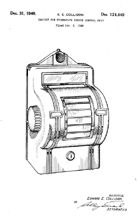
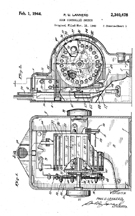
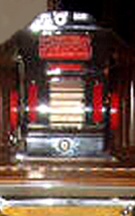
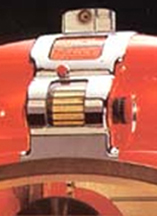
The Collison/Lannerd Selector, Unique to the Packard Series
Collison Jukebox Selector Cabinet D-124,440
Lannerd Jukebox selector Control Mechanism, Patent No. 2,340,478
Collison Lanard Selector on Packard Manhattan (left) and Pla-Mor (right) Jukeboxes
Click to Enlarge
Click here if you want to learn how to get Patent Drawings
Capehart left Wurlitzer in 1939 and reactivated the Packard company. Using a new selector device, he began distributing the Manhattan between 1939 and 1942. During World War II, Capehart converted the Packard Manufacturing Company to war-time operations, manufacturing parts for the Army and Navy. Capehart purchased Duraloo Tool Works and the Niagara Stamping Company as additions to the Packard Company. For five years in a row, the corporation received the coveted Army-Navy E Awards for excellence in war production. The Veterans of Foreign Wars gave him the Medal of Honor for being an outstanding civilian worker. The war ended jukebox production and Capehart turned his attention to elective office.

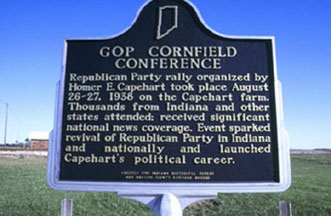
Homer Capehart
Jukebox Entrepreneur and Right Wing Nut
Historical Marker for the Capehart Cornfield Conference
Click to Enlarge
In politics, Capehart became the center-point for a GOP revolution in Indiana and the midwest, mainly by sponsoring a huge "Cornfield-Conference" on one of his farms in 1938. Capehart was first elected to the United States Senate in 1944, narrowly defeating Henry Schricker. When first elected to the Senate, Capehart supported efforts to compromise with the Japanese on terms of surrender. In the Summer of 1945 Capehart feltat that the war might have ended sooner if President Truman would have stated precisely what unconditional surrender meant for the Japanese. He was critical of the Truman administration and the military for their postwar policies in Germany, accusing Truman and General Dwight D. Eisenhower of a conspiracy to starve the remains of the German nation. In a strange twist, Capehart reacted to the Marshall Plan (to feed and rebuild all of Europe after WWII) as "state socialism." His Republican colleague, Senator Joseph McCarthy, of Wisconsin, translated that for the masses as a "massive and unrewarding boondoggle" that had turned the United States into "the patsy of the modern world." Although nowhere near as vulgar as "Tail Gunner Joe", Capehart remained a close colleague of McCarthy during the depths of the Mud-Slinging and Witch-Hunting of the late 1940s and early 1950s. President Truman was definitely not one of his admirers, especially won the question of removing wartime price controls. Capehart managed to get a bill through the newly Republican 87th Congress that would immediately remove controls, even though the economy was ill-poised to supply consumer goods. Congress even overrode Truman's veto. The result was a fairly massive inflation that eventually cost the Republicans the 1948 Pesidential election.
After the war, The Model 7 Pla-Mor was manufactured. This combined the most deeply moulded plastics ever manufactured, and an unusual mechanism that stored the 78rpms vertically to the left of the turntable. By 1949 economic pressures reduced Packard to the manufacture of wallboxes only, and in 1950 Packard was declared bankrupt, selling its phonograph division to Wurlitzer. After Eisenhower, Capehart continued to fight with any administration in power, earning the enmity of Kennedy, Johnaon and Nixon.
Acme Remanufactured Jukeboxes
We knew nothing about the Acme Company until we received this letter from our reader Mike:
"... I thought you might like a photo of a rare Acme Jukebox from the 1940’s. [This has an interesting origin] Since major makers stopped production during the war, parts subcontractors like Acme developed an aftermarket wooden box that could accommodate a wide variety of different jukebox mechanisms. In effect, they were able to make new jukeboxes out of spare parts and discarded mechanisms without using materials that were needed for the war effort. There was a great demand for jukeboxes at the time, especially in USO clubs all over the world
Although several companies made aftermarket boxes, Acme was the largest and thus, "Acme" is a generic name for these machines. There is not a lot of information on either manufacturers and/or models that were made. The only folks that knew about these items were the jukebox vendors who leased and serviced them. Some information about these aftermarket machines may be found in old parts catalogs published for the Coin Operated Machines Association but it is quite limited.
The boxes were a "One Size Fits All" design that would fit many early models like Wurlitzer and Seeburg from 10 to 20 play. The boxes ranged from very simple to extra fancy. I have seen them made from a one piece molded papier-mâché with wooden supports molded into them to a composition made from sawdust and glue. Others had cabinets stamped from metals that were not restricted by war priorities. Here are photos of a wooden box that is the fanciest Acme that I seen so far.
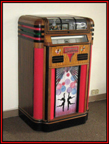

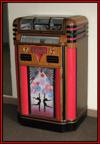
Acme Remanufactured Jukebox
Equipped with a Seeburg Mechanism
Click to Enlarge
Mike continues:
"...In the 1930s, especially in the south, old jukeboxes many vendors store old jukeboxes in barns for parts. In turn, they would become infested with wood beetles that would eat away the boxes, but leave the metal parts. Vendors could combine metal parts with the Acme box to provide machines to meet wartime demand for entertainment. Many of these boxes were sold to the armed forces.
Since the boxes were rebuilt by the vendors, the quality of the product would vary depending on the skill of the vendors' employees. Some are very nice, and others are sloppy. They used whatever parts they had on hand, you may find one that was a Wurlitzer 616 with all the pats of a 616. Another might have a Seeburg mechanism and a Wurlitzer amplifier. Some were set up for coin operation, and others for free play.
There is also a side note about the Wurlitzer exchange program discussed above and the Acme aftermarket boxes. Wurlitzer did exchange and give credit for older boxes toward the purchase of a new one. You'll note that the ad reproduced above hints that Wurlitzer destroyed the old jukeboxes. In fact, the exchange of physical jukeboxes did not last very long. Instead, Wurlitzer only required the vendor to return the coin mechansism in order to show that the old box had been removed from service. Vendors would then store the old boxes to be used for parts. Some venders would buy a new coin mechanism from the parts suppliers and reuse the boxes in lower end spots.
Some vendors simply gave them away. I have found many boxes in basements where the story is the same: Uncle Joe worked in a bar in the old days and when they delivered the new jukebox, they removed the coin mechanism and asked if anyone wanted it. Uncle Joe brought it home in the trunk of his Caddy..."
The KGB and the Jukebox Business
After World War II, England was left more-or-less in ruins. The major cities of the South had been bombed out, the treasury was empty and people had been on a starvation rations diet for more than six years. The Empire was crumbling and Britain's class-oriented scociety was beginning to come apart at the seams as the need for wartime unity ended. In 1945, the voters had unceremoniously tossed Churchill out at the moment of victory, bringing in a Labour government and the nationalization of major industries including steel, coal, and rail transport. The change also brought universal health care, unemployment benefits and the Dole. This sudden shift to the Left seemed to intensify rather than ameliorate class differences, leaving a deeply troubled society that fell victim to two invasive forces: Soviet spies and Rock'n'Roll. Of all things, the two (unwittingly) collaborated to shake up British society.
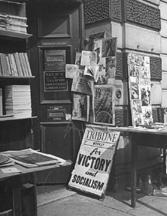
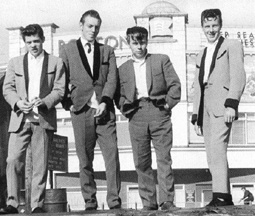
Threats to the British Way Of Life
Haut et Bas
Socialism and Teddy Boys
Click to Enlarge
At the pinnacle of society, the British scientific and arts establishment was shot through with Communist sympathizers who had cut their teeth in the Depression and the fight against Fascism. The war, and England's alliance with the Soviet Union provded fertile ground for the translation of "sympathy" to "espionage." Today, one marvels at the degree to which Soviet spies attained high positions within the government and some say (if you read John Le Carre) at the very top of MI-5, the British Intelligence organization.
At the other end of the social spectrum, another subversive force proved to be even more damaging to the established order. This was, of course, the British Teenager. Like his American cousin, he spent money on commodities for which his elders saw no lasting value like records, make-up and juke box music. At the time, BBC radio had a monopoly on broadcasting and was quite resistant to musical forms that did not conform to its "founding ideals of public education" This meant rock'n'roll. The BBC seemed excessively concerned over the perceived subversive ideological affects of hot American jazz (while at the time, their colleagues in the Foreign Office were apparently not at all concerned about the subversive influences of the KGB...) Juke boxes gave teenagers raw, unfiltered American music, bypassing the BBC altogether. Juke Boxes played a remarkably similar role in America where they allowed kids to circumvent racist restrictions imposed by commercial radio stations.
In 1948, these two subversive trends met and had a zany ten year run and they (unwittingly) collaborated to shake up British society.
The story begins in Cobalt, Ontario, Canada in about 1922. Arnold and Bessie Lonsdale had a son named Gordon. In the same year Konon Molody was born in the Ukraine. Over in Canada, Bessie did not get along with Arnold and, with her child, returned home to her native Finland. In the Ukraine, Konon's father died when he was a child and his mother sent him to live with an aunt in California. Genrikh Yagoda, then head of the Soviet secret police, helped the boy get a passport to go to America. It seems that the KGB had their eyes on him when he was only 12 years old. Konon grew up speaking English, but returned to the Soviet Union and served with valor in World War II.
Gordon Lonsdale fought with Finland on the losing side of the tragic Russo-Finnish war of 1939-1940. He was captured and died of pneumonia in a prison camp. When the Soviet Union won that war, it inherited public records -- and made very good use of Gordon's Canadian passport. By simple forgery, Konon became Gordon.
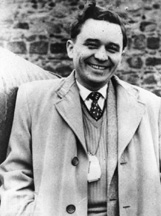
Konon Molody in London about 1958
alias Gordon Lonsdale
Click to Enlarge
After a brief stint on a student visa in the US, Molody/Lonsdale traveled to England, destined to be the first official "resident" or chief-spy-in-place.
We'll pause here for a moment to consider the most important quality of a good spy: He/She must be unnoticed! The prime dictum of intelligence work is that the spy should never call attention to himself. This is drilled into recruits averywhere in the world whether it is CIA, MI5, the Deuxieme Bureau, or the KGB. You have probably guessed what Molody did not do, but we'll move on now that you know that it is vitally important for a spy to be anonymous.
Gordon Lonsdale established himself in the vending machine business. This was a good cover because it allowed him to travel widely within England and gave him entre into shops, pubs and the like around sensitive areas, like defense plants. Servicing the machines was relatively easy to learn, and could provide cover jobs for lower-level spies, especially those with lesser facility in English, possibly posing as refugees from Hungary, Czechoslovakia or East Germany. This worked well and eventually led Lonsdale into the juke box business.
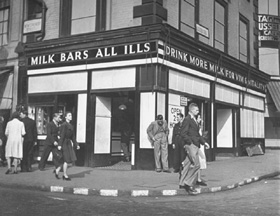
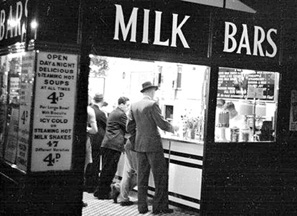
The Milk Bar
Hotbed of Teenage Rebellion
Equivalent to the US Malt Shop
Click to Enlarge
Apparently, Molody/Lonsdale had a fantastic ear for music, even though he shared the Russian establishment's antipathy toward jazz, especially "race" music like blues and Rock. On the other hand, he knew what "sold" and was very adept at stocking his jukeboxes with records that would rain a shower of nickels into his coffers. At this point, I am reminded of the recent Austin Powers film in which the villain, "Dr. Evil" returns from cryogentc storage to find out that his enterprise is making more money from legitimate activities than criminal ventures. Indeed, Molody's jukebox business provided an enormous amount of foreign exchange for the KGB. (This success in the capitalist world was cause for some concern in Moscow.) Since the business was all in cash, opportunities abounded for money laundering and under-the-table payments.
The problem was that Gordon Lonsdale achieved significant popularity among the musicians whose records he helped to promote. In a PBS interview, KGB historian Igor Prelin summed up Molody/Lonsdale's business acumen:
"... Lonsdale was a very good businessman. Actually it should be said that he started from scratch. First it was the jukeboxes, then slot machines, then at a later stage, different kind of machines selling drinks, cigarettes, sandwiches and all that, and he was quite wealthy. He had several houses in Britain. He got the two rooms in the hotels permanently. He had several cars and this allowed him not only to properly operate all his activities, but he even never asked for money from the [KGB] centre. He even managed to pay the agents out of his business ..."
It is said that Lonsdale almost singlehandledly created the Skiffle Revival that fueled the early careers of Eric Clapton, John Mayall, Jeff Beck, Ginger Baker, Jimmy Page, Graham Nash, and Keith Richards. In addition, an obscure group named The Quarrymen (i.e. the Beatles less Ringo) also had a presence on Lonsdale's playlists. If you hang around with pop stars, then fancy clothes, cars, and women are not far behind. Gordon Lonsdale became a social lion, attending premieres, receptions and generally enjoying the fruits of celebrity. He even met the Queen and was inducted into the Royal Society.
He also conducted a brisk espionage business, obtaining detailed information about NATO's submarine forces. The end came by accident -- one of his informants, an upper class twit named Houghton talked too much in bed. Eventually, he was caught and tried. He served three years in prison and was eventually exchanged for Grenville Wynne a British spy held by the Soviets. Prelin also has an amusing anecdote about his position in Society:
"... Scotland Yard put an arrest on all his property in UK, the houses, the cars and everything including the library. Had a very rich library, which contains not only modern books, but also some Asian books including Chinese manuscripts. After few years in jail he was exchanged for Greville Wynne. When he got back to the Soviet Union, and he tried some how to get this rest of his property, but in vain. And then he recollected that he was a member of the Royal Society, and he decided to do nothing more or less than to write letter to Her Majesty the Queen requesting a return at least of his library. And the Queen made a decision, and the library was packed and sent back to him to the Soviet Union ..."
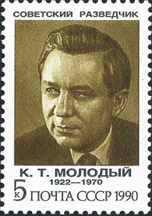
Konon Molody Rehabilitated
The Five Kopek Stamp
Click to Enlarge
He initially received a hero's welcome in Moscow. Eventually, he fell out of favor and died suddenly in 1970 while on a mushroom-picking expedition. How's that for suspicious. His grave did not have a marker on it for nearly 20 years. He was was somewhat rehabilitated in 1990 and his portrait appears on a 5 Kopek postage stamp (less than one cent). Rock and Roll seems to have done a whole lot better
Organized Crime and the Jukebox Business
Robert F. Kennedy's book about organized crime, The Enemy Within begins with the following:
In November, 1957, at least fifty-eight men met on an estate in upper New York near the town of Apalachin. They had come from all over the United States. Joseph Francis Civillo came from Texas; James Coletti, from Colorado; the Falcone brothers, from New York; Vito Genovese, from New Jersey; Bill Bufalino, from Pennsylvania; Santos Trafficante, from Tampa, Florida. Fifty of the fifty-eight had arrest records, thirty-five had convictions. Eighteen had been arrested or questioned in connection with murders, fifteen in connection with narcotics, twenty-three for illegal use of firearms. The host, Joseph Barbara, had been the chief suspect in two murders. They were also active in many so-called legitimate enterprises. Nineteen were involved in garment manufacturing; seven, in trucking; nine were or had been in the coin-machine business; seventeen owned taverns or restaurants; eleven were in the olive oil-cheese importing or exporting business. Others were involved in automotive agencies, coal companies, entertainment; four in funeral homes; one was a conductor of a band; and twenty-two were involved in labor or labor-management relations.
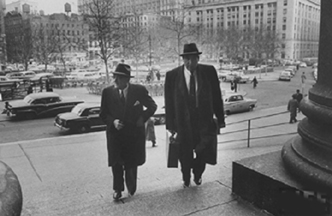
Vito Genovese Called to Testify on the Jukebox Racket
Click to Enlarge
The part about "coin operated machines" stood out, especially since I was preparing this page on Jukeboxes. My research has turned up a lot of material, but I'm going to limit it to a few choice anecdotes.
Jukeboxes (and other coin operated machines) have been attractive to organized crime almost from the beginning. The mob is especially lured to cash businesses where it is possible to "skim" off profits before any taxes are paid. In addition, cash business are a perfect place to launder money. In general, criminals have little interest in servicing the machines. Rather, they want to be there when the cash is collected. In general, the companies (Wurlitzer, Seeburg, etc.) did not sell jukeboxes directly to bars, restaurants and the like. Rather, the machines were sold to operators or middlemen who would place the boxes, service them, and split the take with the owners. In general, the mob was involved directly as operators, or through control of some sort of operator association. In some localities, the service staff was unionized (often represented by the Teamsters.) Territories are established so that the gang has a complete monopoly; independent operations are run out through intimidation, sabotage or labor trouble. Restaurant and bar owners are forced to use jukeboxes from the mob-backed operator by the same means. These techniques are also used for slot machines, pinball, and cigarette vending.
Practically speaking, none of the jukebox companies was entirely free of organized crime connections. Here are a few notable examples of the mob touching the jukebox industry.
In 1928, David Rockola was a smalltime slot machine operator and Henry Swanson had just been elected as the reform District Attorney of Cook County. Swanson had run on a promise of cleaing up illegal gambling, particularly slot machines.
As a brand new DA, Swanson was not only hampered by having a new and inexperienced staff, but also by conflicting local laws and regulations concerning slots. It was easier to run against them than to prosecute them because (a) Slot machines were legal in next-door Indiana and (b) The Illinois Attorney General had ruled that slot machines that did not give cash payouts were legal. (Some machines were set to give out tokens or vouchers that could be redeemed for cash).
In 1929, after several months of questioning manufacturers, owners, distributors and players, Swanson was able to force two small timers to testify -- David Rockola and William Keeney whose testimony led to an indictment of the Southside Slot Syndicate of James N. "High Pockets" O’Brien.
Keeney testified he did split profits with O’Brien on slots, however the machines were either the legal token type or were operating in Indiana. He also stated "High Pockets" (via his minion Rockola) introduced illegal mechanical additions to his machines that gave immediate payouts. Rockola testified that he had retrofitted payout devices on slots for the biggest slot companies in the world. Two in particular, Jennings and Mills Novelty, were companies with major ties to Frank Costello and other mob families in New York City as well as the Chicago mobs.
In return for immunity, Rockola testified about the slot machine racket in Chicago. Corruption was so rampant that he and an accomplice were able to get several truckloads of confiscated slot machines by paying $500 to one sergeant and two police captains. He was called "Crown Prince" of the slot syndicate by the Chicago press.
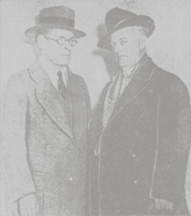
The future Jukebox King (and Lawyer)
(left) David Rockola
(right) Attorney Louis Piquette (later to be John Dillinger's last lawyer).
Click to Enlarge
Rockola was eventually convicted of several minor offenses. He avoided jail through a series of appeals. He received a pardon after a respectable period of time had elapsed. The ease with which he avoided jail and retribution have led some to believe that "High Pockets" was framed by rival gangsters and that Rockola was selected to give the damning evidence. Rockola had no trouble finding finance and connections for his subsequent foray into jukeboxes and vending machines.
In Detroit, things took an unusual twist. Without mob impetus, jukebox operators conspired together during the 1930s to control the business by forming a "captive uninon" that represented their own interests -- keeping territories intact and keeping out new competition. They were fairly successful and it became known that jukebox operations in Detroit were quite profitable. However,"live by the sword" is most frequently accompanied by "die by the sword." The Kefauver Hearings in Congress found that in 1940, organized crime simply took over the operators association that was a fumbling amateur compared to the experience, muscle, and tactics of the Mob. By 1946, the jukebox industry in Detroit was completely under the control of the crime syndicate and Teamsters Local 985 was used as the enforcer. This was less a case of "mob infiltration" than just switching one anticompetitive regime for another. The difference between "business" and "cosa" is often a matter of whether or not there is a vowel at the end of one's name.

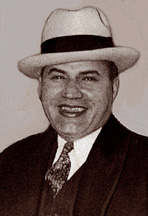
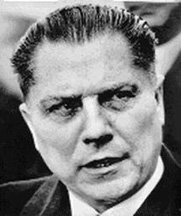
Heierarchy in the Detroit Jukebox Racket
William Bufalino, Angelo Meli and James Riddle Hoffa
Click to Enlarge
Of note, the investigation of Teamsters Local 985 in connection with the jukebox rackets led first to William Bufalino, head of the local, to Angelo Meli, head of the Detroit Crime Syndicate and thence to Jimmy Hoffa. Once Hoffa got into the national spotlight, it glared at him until he was convicted and sent to prison.
In the 1930s, New York was the center of both population and the entertainment industry. It is therefore logical that the revenues to be had from jukeboxes in New York and its immediate surrounds (New Jersey and Connecticut) would be immense. New York was also the center of organized crime, and it follows that the jukebox industry would be a prime target. This was the case, in a most spectacular fashion.
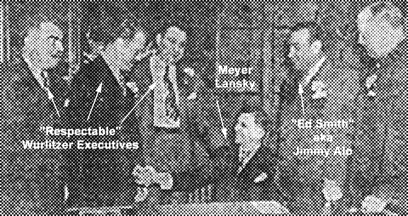
The New Wurlitzer Distributor for NY, NJ, and CT
(seated) Meyer Lansky, Legendary Syndicate Kingpin
"Ed Smith" (possibly Jimmy "Blue Eyes" Alo)
Various "Respectable" Wurlitzer Executives
Click to Enlarge
"... At a trade gathering, several Wurlitzer Company executives presented Meyer Lansky and his associate Ed Smith to the Eastern box operators. Said Wurlitzer official Mike Hammergreen: 'We know that in Meyer Lansky we have a man who is liked and respected by everyone.. we are confident that Wurlitzer's new distributor in New York, New Jersey and Connecticut will make many new friends." When questioned about his plans, Lansky intimated that he 'would much prefer to have his actions speak for him' ..."
This revelation was nothing short of astounding because Meyer Lansky was one of the top figures in the Organized Crime Syndicate and had bee identified in the press as such for many years. He was known primarily as the mob's chief banker but he was also involved in the formation and management of organized crimes liquidation department -- the notorious Murder Inc.. In 1934, Lansky's name may have been unfamiliar to the general public but his connections to organzized crime could not have escaped the editors of Billboard ... or Wurlitzer!
You might be interested on the background for the entry of Mr. Lansky into the world of jukeboxes. It started several years before in the seedy hamlet of Hallendale Florida
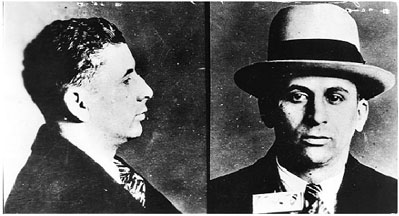
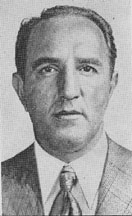
Meyer Lansky and Vincent "Jimmy Blue Eyes" Alo
Click to Enlarge
Lansky was the basis for the character Hyman Roth and Alo was the basis for "Johnny Ola, Roth's Sicillian Messenger Boy" in The Godfather, Part II
In 1929, Vincent "Jimmy Blue Eyes" Alo was introduced to Lansky by Lucky Luciano, Since Lansky was a valuable money-maker, Luciano wanted Alo to guard him. Both Lansky and Alo were introverted, bookish men who wanted to become legitimate businessmen. The two mobsters soon became friends. At the time, Lansky was setting up a partnership between the police, politicians and merchants in Hallendale, a rundown village outside Miami. Lansky built a small casino that made unbelieveable amounts of money, drawing gamblers from all over the south. The crowds threatened to blow the cover from his operation and wreck his carefully orchestrated partnership with the authorities. Clearly, the market for gambling had not been saturated, so another, and then another "underground casino" was opened. This was followed by Gulfstream Park and horse racing.
The fountain of cash from Hallendale had to be laundered, and hence Lansky and Alo formed the Simplex Distribution Company and got the Wurlitzer franchises discussed above. All worked fairly well throughout the "golden Age" of the jukebox. The move into jukeboxes also gave Lansky and Alo control of the popular music outlets during the 1940s in the massive New York market. To no small degree Frank Sinatra's amazing career took off as a result of the hoods' control of what records appeared in their jukeboxes. Unfortunately for Sinatra, the mob was simultaneously pressing millions of bootleg copies of Sinatra's records and selling them from record store outlets. The mob giveth and taketh away.
By 1947, growth in Broward County had gentrified Hallandale. The casinos there were pretty dilapidated and Lansky sold them to locals, turning his attention to Las Vegas and Cuba. The local yokels were no match for "Good Government" and in 1947 the city was cleaned up and rechristened "Hallandale Beach." Gulfstream Park was spared.
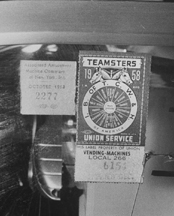
Teamsters Sticker From 1958
Did the Mob Exit the New York Jukebox Business in 1947?
Click to Enlarge
In the same year, Lansky sold Simplex Distribution to a group of supposedly non-mob investors. Wurlitzer maintains that it knew nothing of Lansky's activities until 1947 and that Lansky gave up the franchise as soon as Wurlitzer requested it from him. If you believe that, maybe you also believe in the tooth fairy.
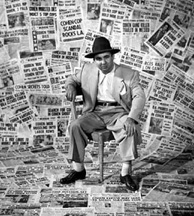
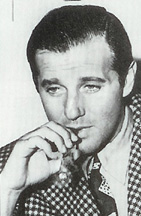
Mickey Cohen and Bugsy Siegel
Click to Enlarge
It is said that Meyer Lansky sent Mickey to the Coast to keep an eye on Bugsy Siegel for the national syndicate. During their association, Cohen helped set up Siegel's Flamingo Hotel in Las Vegas and ran its sports book operation. In 1947, the crime families ordered the murder of Siegel due to his mismanagement of the Flamingo Hotel, most likely because Siegel or his girlfriend Virginia Hill was skimming money. The Los Angeles crime syndicate was taken over by Frank Carbo of the Dragna family.
Despite this changeover, Cohen continued to run his own gambling and extortion operations. In particular, he owned a nightclub called the "Rhum Boogie" that started a large number of R&B acts on their way -- their careers controlled, of course, by Cohen. He also controlled jukebox operations in the vast LA market, something that gave him enormous leverage over the direction of [what was then called] "race" music by having both the performers and the outlet for distribution. [R&B was customarily not played on the radio.]
His activities came to be at cross purposes with the Dragna family, and soon Cohen faced many attempts on his life, including the bombing of his home on posh Moreno Avenue in Brentwood.
At that time, Cohen's bodyguard was Johnny Stompanato, a good looking thug who had a side business as a gigolo. Stompanato was the muscle for collections from jukebox owners. In the scope of jukebox rackets, this would be of negligible importance, because it is said that the take from the racket was only about $1 (in 1947 dollars, about $20 today) per machine, since the real profits came from exploiting record sales and money laundering.
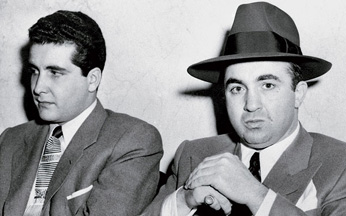
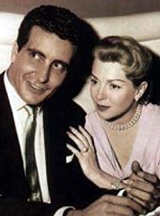
Johnny Stompanato and Close Friends
(left) Johnny and Mickey (right) Johnny and Lana
Click to Enlarge
Stompanato would have been, at best, a footnote in the history of crime in LA. However, one morning, Johnny turned up dead, ostensibly having been stabbed by Lana Turner's daughter. The combination of Mob, Movies and Murder kept the story alive for months. Many people thought that Turner herself had stabbed Stompanato in a lovers quarrel, and that the blame was placed on her daughter (Cheryl Crane) to preserve Ms. Turner's career and because the teenager would receive a mild sentence. In the end, Crane was acquitted, and Turner went on to become an even bigger star.
Cohen showed his loyalty to his former jukebox collector by bying a cheap coffin for Stompanato's funeral and then selling Lana Turner's love letters to the press.
Once again, you have a some choices:
- Read about Jukebox Mechanics Separate page
- Read about Jukebox Aesthetics Separate page
- Read about The End of the Jukebox Era Separate page
- Look at Some Other Kind of Swing Era Nonsense
Counter for THIS Web Page
Home | About Lindy | 1940s Collectibles | Upcoming Events | Vintage Clothing
The Guide - Establishments - Travel - Accessories
Music | Links | Photo Gallery | Extras | Contact